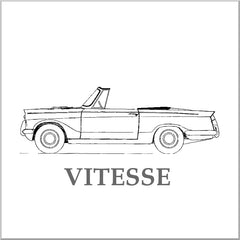When we started our development in early 1984 to reproduce interior trim for Triumph cars, we honestly didn't realise how complex a subject this was going to be. Our company policy then (as it still is today) was that we would only reproduce these items as near to original specification as possible, so to to this end we found original and new suppliers to accommodate this.
We produce trim for the Triumph Herald 1200, 12/50 and 13/60, the Triumph Vitesse 6 & 2 litre models, the Triumph Spitfire and Triumph GT6.
Select your model....
Giraffe
The giraffe is a large African hoofed mammal belonging to the genus Giraffa. It is the tallest living terrestrial animal and the largest ruminant on Earth. Traditionally, giraffes were thought to be one species, Giraffa camelopardalis, with nine subspecies. Most recently, researchers proposed dividing them into up to eight extant species due to new research into their mitochondrial and nuclear DNA, as well as morphological measurements. Seven other extinct species of Giraffa are known from the fossil record.
The giraffe's chief distinguishing characteristics are its extremely long neck and legs, its horn-like ossicones, and its spotted coat patterns. It is classified under the family Giraffidae, along with its closest extant relative, the okapi. Its scattered range extends from Chad in the north to South Africa in the south, and from Niger in the west to Somalia in the east. Giraffes usually inhabit savannahs and woodlands. Their food source is leaves, fruits, and flowers of woody plants, primarily acacia species, which they browse at heights most other herbivores cannot reach.
Lions, leopards, spotted hyenas, and African wild dogs may prey upon giraffes. Giraffes live in herds of related females and their offspring or bachelor herds of unrelated adult males, but are gregarious and may gather in large aggregations. Males establish social hierarchies through "necking", combat bouts where the neck is used as a weapon. Dominant males gain mating access to females, which bear sole responsibility for rearing the young.
The giraffe has intrigued various ancient and modern cultures for its peculiar appearance, and has often been featured in paintings, books, and cartoons. It is classified by the International Union for Conservation of Nature (IUCN) as vulnerable to extinction and has been extirpated from many parts of its former range. Giraffes are still found in numerous national parks and game reserves, but estimates as of 2016 indicate there are approximately 97,500 members of Giraffa in the wild. More than 1,600 were kept in zoos in 2010.


Elephants
Elephants are the largest land mammals on earth and have distinctly massive bodies, large ears, and long trunks. They use their trunks to pick up objects, trumpet warnings, greet other elephants, or suck up water for drinking or bathing, among other uses. Both male and female African elephants grow tusks and each individual can either be left- or right-tusked, and the one they use more is usually smaller because of wear and tear. Elephant tusks serve many purposes. These extended teeth can be used to protect the elephant's trunk, lift and move objects, gather food, and strip bark from trees. They can also be used for defense. During times of drought, elephants even use their tusks to dig holes to find water underground.
Zebras
Zebras (US: /ˈziːbrəz/, UK: /ˈzɛbrəz, ˈziː-/)[1] (subgenus Hippotigris) are African equines with distinctive black-and-white striped coats. There are three living species: the Grévy's zebra (Equus grevyi), plains zebra (E. quagga), and the mountain zebra (E. zebra). Zebras share the genus Equus with horses and asses, the three groups being the only living members of the family Equidae. Zebra stripes come in different patterns, unique to each individual. Several theories have been proposed for the function of these stripes, with most evidence supporting them as a deterrent for biting flies. Zebras inhabit eastern and southern Africa and can be found in a variety of habitats such as savannahs, grasslands, woodlands, shrublands, and mountainous areas.
Zebras are primarily grazers and can subsist on lower-quality vegetation. They are preyed on mainly by lions, and typically flee when threatened but also bite and kick. Zebra species differ in social behaviour, with plains and mountain zebra living in stable harems consisting of an adult male or stallion, several adult females or mares, and their young or foals; while Grévy's zebra live alone or in loosely associated herds. In harem-holding species, adult females mate only with their harem stallion, while male Grévy's zebras establish territories which attract females and the species is promiscuous. Zebras communicate with various vocalisations, body postures and facial expressions. Social grooming strengthens social bonds in plains and mountain zebras.
Zebras' dazzling stripes make them among the most recognisable mammals. They have been featured in art and stories in Africa and beyond. Historically, they have been highly sought after by exotic animal collectors, but unlike horses and donkeys, zebras have never been truly domesticated. The International Union for Conservation of Nature (IUCN) lists the Grévy's zebra as endangered, the mountain zebra as vulnerable and the plains zebra as near-threatened. The quagga (E. quagga quagga), a type of plains zebra, was driven to extinction in the 19th century. Nevertheless, zebras can be found in numerous protected areas.






